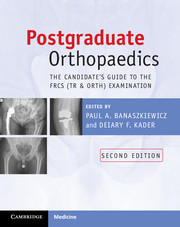Book contents
- Frontmatter
- Contents
- Contributors
- Foreword
- Preface to second edition
- Abbreviations
- Section 1 The FRCS (Tr & Orth) examination
- Section 2 The written paper
- Section 3 The clinicals
- Chapter 3 The short cases
- Chapter 4 The intermediate cases
- Chapter 5 Shoulder and elbow clinical cases
- Chapter 6 Hand and wrist clinical cases
- Chapter 7 Spine clinical cases
- Chapter 8 Hip clinical cases
- Chapter 9 Knee clinical cases
- Chapter 10 Foot and ankle clinical cases
- Chapter 11 Paediatric clinical cases
- Section 4 The adult elective orthopaedics oral
- Section 5 The hand oral
- Section 6 The paediatric oral
- Section 7 The trauma oral
- Section 8 The basic science oral
- Section 9 Miscellaneous topics
- Index
- References
Chapter 5 - Shoulder and elbow clinical cases
from Section 3 - The clinicals
- Frontmatter
- Contents
- Contributors
- Foreword
- Preface to second edition
- Abbreviations
- Section 1 The FRCS (Tr & Orth) examination
- Section 2 The written paper
- Section 3 The clinicals
- Chapter 3 The short cases
- Chapter 4 The intermediate cases
- Chapter 5 Shoulder and elbow clinical cases
- Chapter 6 Hand and wrist clinical cases
- Chapter 7 Spine clinical cases
- Chapter 8 Hip clinical cases
- Chapter 9 Knee clinical cases
- Chapter 10 Foot and ankle clinical cases
- Chapter 11 Paediatric clinical cases
- Section 4 The adult elective orthopaedics oral
- Section 5 The hand oral
- Section 6 The paediatric oral
- Section 7 The trauma oral
- Section 8 The basic science oral
- Section 9 Miscellaneous topics
- Index
- References
Summary
Introduction
The shoulder and elbow clinical cases in the exam consist of patients with good signs for you to demonstrate and are usually pain-free. However, as a subspecialty candidates are often nervous about the content. Stick to the principles of history and examination, and most diagnoses will become apparent.
Many of the cases illustrated in this chapter are from the previous long case examination. The cases themselves are equally applicable to the intermediate cases, but obviously require a more focused approach in the new format.
- Type
- Chapter
- Information
- Postgraduate OrthopaedicsThe Candidate's Guide to the FRCS (Tr and Orth) Examination, pp. 24 - 35Publisher: Cambridge University PressPrint publication year: 2012

